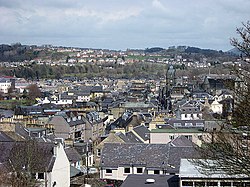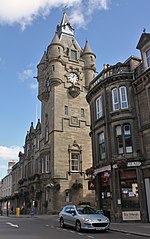Hawick
| Hawick | |
| Roxburghshire | |
|---|---|
 Hawick from the top of the Mote | |
| Location | |
| Grid reference: | NT505155 |
| Location: | 55°25’20"N, 2°47’15"W |
| Data | |
| Population: | 14,801 (2001) |
| Post town: | Hawick |
| Postcode: | TD9 |
| Dialling code: | 01450 |
| Local Government | |
| Council: | Scottish Borders |
| Parliamentary constituency: |
Berwickshire, Roxburgh and Selkirk |
Hawick is a town in Roxburghshire, in the heart of Teviotdale, and reckoned to be the biggest town in the shire. It stands on the River Teviot at its meeting with the Slitrig Water, 10 miles south-west of Jedburgh and 9 miles south-southeast of Selkirk.
Hawick's architecture is distinctive for its many sandstone buildings with slate roofs.
Hawick is known for its yearly Common Riding and for its knitwear industry. Several companies have or have had manufacturing based in Hawick, including Hawick Cashmere, Hawick Knitwear, Johnstons of Elgin, Lyle and Scott, Peter Scott, Pringle of Scotland, and Scott and Charters, between them producing some of the most luxurious cashmere and merino wool knitwear in the world today. The first knitting machine was brought to Hawick in 1771 by John Hardie, building on an existing carpet manufacturing trade. Originally based on linen, this quickly moved to wool and factories multiplied, driving the growth of the town.
Well known too in rugby circles is its rugby team Hawick RFC.
Sights of the town

The west end of the town contains "the Mote", the remains of a Norman motte-and-bailey. In the centre of the High Street is the Scots baronial style Town Hall, built in 1886, and the east end has an equestrian statue, known as "the Horse", erected in 1914.
Drumlanrig's Tower, now a museum, dates largely from the mid-16th century.
Local traditions
The town hosts the annual Common Riding, which combines the annual riding of the boundaries of the town's common land with the commemoration of a victory of local youths over an English raiding party in 1514. In March 2007, this was described by the tourism Rough Guide as one of the best parties in the world.[1]
People from Hawick call themselves "Teries", after a traditional song which includes the line "Teribus ye teri odin".
Ba game
The Hawick Baw game was once played here by the 'uppies' and the 'doonies' on the first Monday after the new moon in the month of February. The river of the town formed an important part of the pitch. Although no longer played at Hawick, it is still played at nearby Jedburgh.
Transport
Hawick lies in the centre of the valley of the Teviot. The A7 Edinburgh to Carlisle road passes through the town. Main roads also lead to Berwick-upon-Tweed (the A698) and Newcastle upon Tyne (the A6088, which joins the A68 at the Carter Bar, 16 miles south-east of Hawick).
Despite a great deal of local opposition, the town lost its rail service in 1969, as part of the controversial Beeching Axe. It is now said to be the farthest large town from a railway station in the United Kingdom. There have been plans to reinstate the line from Edinburgh to Tweedbank, but not to Hawick.

Other sports
The town is the home of Hawick Rugby Football Club]] and a senior football team, Hawick Royal Albert.
Rivalry between the small Border towns is generally played out on the rugby union field. The historical competition continues to this day, as Hawick's main rival is the similarly-sized town of Galashiels.
Teri Talk
Many Hawick residents speak the local dialect of Border Scots which is informally known as "Teri Talk"[2]. It is similar (but not identical by any means) to the dialects spoken in surrounding towns, especially Jedburgh, Langholm and Selkirk.
The speech of this general area was described in Dialect of the Southern Counties of Scotland (1873) by James Murray, considered the first systematic study of any dialect. The Hawick tongue retains many elements of Old English, together with particular vocabulary, grammar and pronunciation. Its distinctiveness arose from the relative isolation of the town.
Villages close by
Close by Hawick's are:
Outside links
| ("Wikimedia Commons" has material about Hawick) |
- The Hawick Highland Games
- The Online Resource for Hawick
- Southern Scots
- Old Photographs of Hawick and The Scottish Borders
- Photos Of Hawick
- Picture of the ba game at Hawick dated 1904
- A Hawick Wordbook - Douglas Scott
References
- ↑ "Guide book praises common riding". BBC. 2007-03-13. http://news.bbc.co.uk/1/hi/scotland/south_of_scotland/6441611.stm. Retrieved 2009-05-16.
- ↑ Teri Talk
Further reading
- Murray, James (1870–72, 1873) The Dialect of the Southern Counties of Scotland, London: Philological Society
